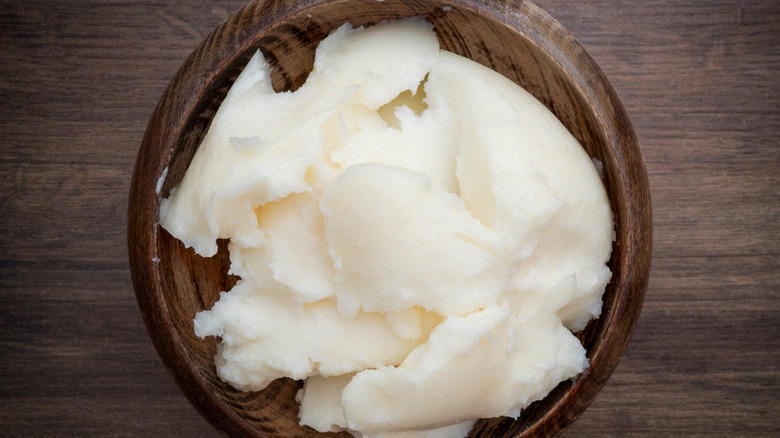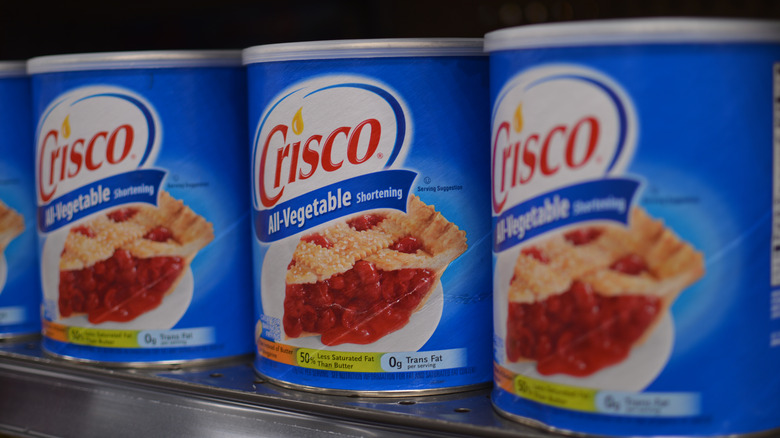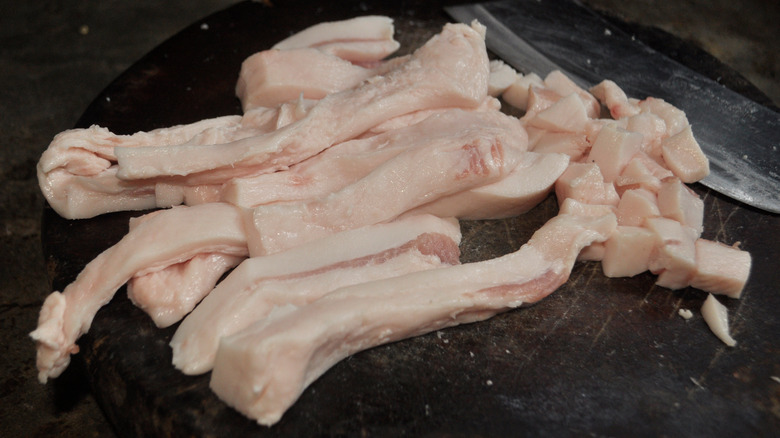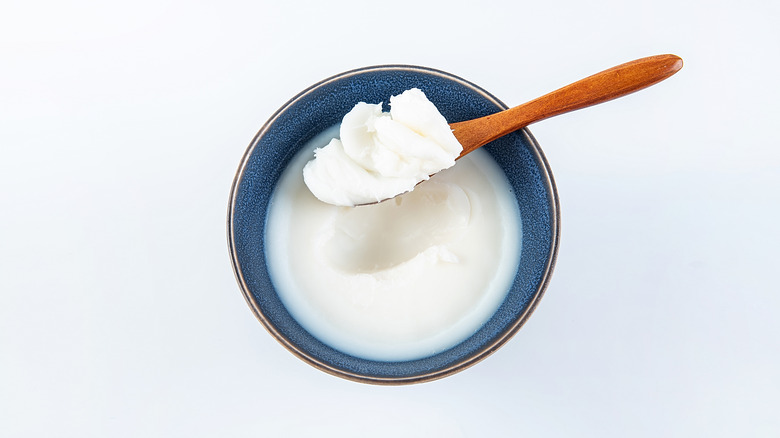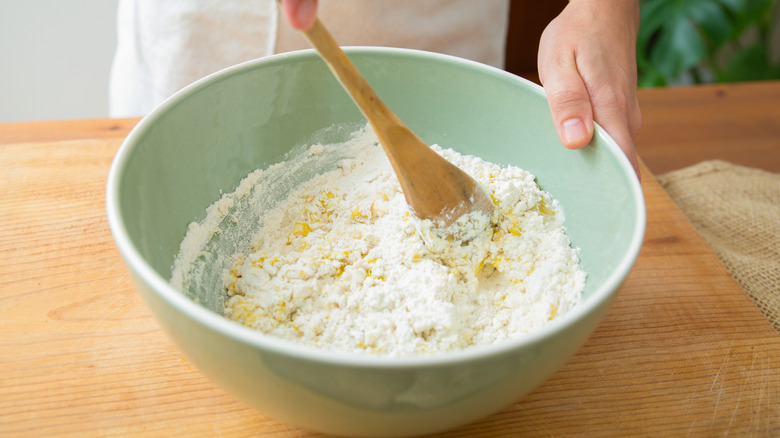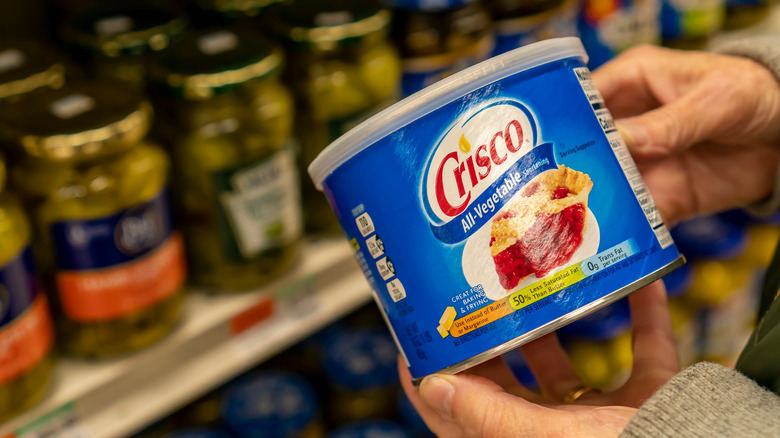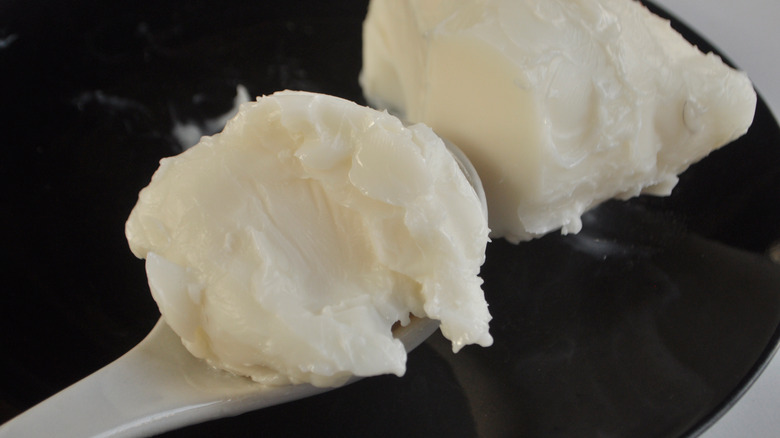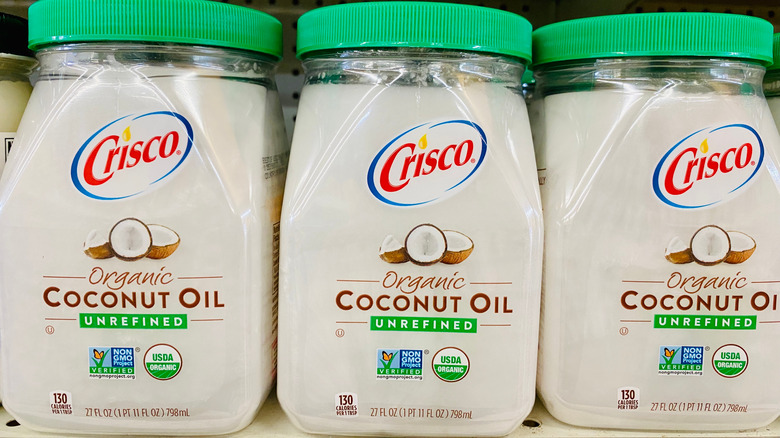What Is Shortening And Is It Nutritious?
Do enough baking and eventually you'll come across recipes that call for "shortening." A popular ingredient in pie crusts and other flaky pastries, shortening may sound like an old-fashioned ingredient that you're more likely to find in your grandmother's kitchen than in your own, but the word doesn't just apply to that blue Crisco can that it may conjure up in your mind's eye. Instead, "shortening" applies to a range of fat products. According to the Cambridge dictionary, "shortening" is "a type of solid vegetable oil, or sometimes butter or lard (fat from animals) that is used in cooking, especially to make pastry soft and crumbly (easily broken)."
So where can you get some of this magical ingredient for yourself, for a better pastry crumb for your next baking project? And how do you use it to obtain the desired effect? How does the nutritional information for shortening stack up against other fats you might want to use in your baking? Here's everything you need to know about shortening.
What is shortening?
As you probably noticed, the textbook definition of "shortening" is pretty vague. The baking pros at Bob's Red Mill break down the definition further by explaining that shortening is considered any fat that remains solid at room temperature — but it's still a little more complex than that. As they note, "While butter technically fits the definition, being solid at room temperature and used in baking, most people still don't consider butter to be in the shortening family. In reality, shortening is more a type of ingredient than a specific ingredient."
Originally, shortening referred only to lard (a.k.a. rendered pig fat). But as food science progressed and more, similar products came on the market — such as Crisco and margarine — they were lumped into the same category as lard, probably because, like lard, shortening products like Crisco are made from 100% fat. While your butter can also sit out at room temperature without melting, it can't claim that it's 100% fat. Instead, it comes in around the 80% mark, with a lot of moisture and liquid content making up the rest of its composition, as King Arthur Baking Company points out.
So, a better definition for shortening could be a baking product that's 100% fat and that remains solid at room temperature.
How is shortening made?
A lot of science goes into making shortening, unless you're making lard. If you're making lard, the process is easy enough to follow at home, as food blog Daring Gourmet shows. All you need to do is get your hands on some pig fat (which a local butcher should be able to assist with) and then melt it over low heat, either on the stove or in the oven. After you remove any unmelted bits, the lard cools and then you have a white shortening substance that looks almost identical to Crisco. The same process is followed to make lard on a large scale.
For vegetable oil-based shortenings like Crisco, though, the process is all about the chemistry, so it's likely not something you can replicate at home. Manufacturers start out with vegetable oil (or sunflower or another type of oil) and then add hydrogen to the oil, which puts the oil in a solid state, perfect for spreading and adding to your baked goods. That's literally it. It's a simple process, but one that makes a huge difference to the oil's chemical makeup, resulting in the shortening products most of us are familiar with.
What does shortening taste like?
Just like the manufacturing process differs according to the type of shortening you're making, the taste and smell also differ according to the type of shortening you're using. If you're using something like Crisco or another oil-based shortening, the flavor profile is pretty bland. It's just going to taste and smell like oil. That only changes if your oil-based shortening has gone bad, in which case it'll start to taste and smell rancid.
If prepared correctly, lard also has a pretty neutral, bland taste. However, under the right circumstances, lard will taste noticeably like pork. This isn't always a bad thing, though. While that porky taste is usually associated with lard that's of a lesser quality, some cooks may find it desirable for frying or cooking savory foods. If, however, you're baking up a cake or a pie, you most likely don't want that porky flavor and you'd do best to opt for a higher-quality lard.
How to cook with shortening
Baking is a pretty scientific process. Bob's Red Mill breaks down all of the science behind what shortening does when you add it to a baking recipe, but the TL/DR version is that shortening interacts with the gluten in your dough, preventing the gluten from expanding to its full extent, resulting in a crumbly, crispy, sturdier baked good. This is why the texture of, for example, a pie crust is so different from the texture of bread. Sure, they're both baked items made from dough and, in most cases, contain a lot of the same ingredients, but that shortening makes all the difference.
Despite its big impact, though, cooking with shortening is pretty easy. Just add it in as your favorite baking recipe dictates — and make sure that, when a recipe tells you to "cut" the shortening in, you actually do so. That also plays a role in your baked good's end texture. You can cut the shortening into your dry ingredients with a fork, your hands, etc., simply cutting the shortening into smaller and smaller portions as it mixes with the flour, creating a crumby, almost sandy, texture, or you can let a food processor do the work for you.
Other than baking, shortening is also popular for use in frostings, as the high melting point and stability make it a desirable fat alternative to butter.
Where to buy shortening
You can buy shortening in the baking aisle of any local grocery store, usually around the rest of the shelf-stable oil products. There's no need to go to a specialty store. Crisco will be your most prominent option at most retailers. If you're looking for lard, you may be able to find it at some grocery stores, depending on the region you live in (it's often more popular in the American South), but, if not, you can also ask your local butcher for some. If you're looking to save a little cash in your grocery budget, vegetable oil-based shortening is usually your cheapest option, compared to lard.
Before you throw that shortening in your cart, you may want to check the nutrition label for trans fats, though. While many shortening brands no longer contain trans fats, as trans fats have become notorious for their negative health effects, you may find the odd brand here or there that still includes them.
Nutritional information about shortening
Since Crisco is the most familiar form of shortening, let's take a look at its nutritional value first. A serving of Crisco's all-vegetable shortening is 1 Tablespoon and includes 110 calories, 12 grams of fat, 3.5 grams of saturated fat, no trans fat, 6 grams of polyunsaturated fat, and 2.5 grams of monounsaturated fat. And that's it (remember we told you how shortening is 100% fat?). The brand claims that this all means that Crisco contains 50% less saturated fat than butter and it's an "excellent" source of Omega-3 fatty acid. It also contains no cholesterol.
Lard, on the other hand, also comes in a serving size of 1 Tablespoon, with 115 calories, 12.8 grams of fat, 5 grams of saturated fat, no trans fat, and 12.2 milligrams of cholesterol.
Like any fat, you want to use any shortening in moderation and it doesn't hurt to actively avoid any brands of vegetable-based shortening that do contain those nasty trans fats.
Shortening substitutes
Looking for something to take shortening's place in your favorite baking recipe? While nothing will exactly replicate shortening, you can use other fats in lieu of the ingredient. Popular shortening substitutes include coconut oil (which, like a shortening, remains solid at most room temperatures), butter, and margarine, and you likely want to pick your substitute according to what you're making. If you're making cookies, Food52 recommends using a mix of coconut oil and butter to account for butter's higher moisture content. If you're making biscuits or bread, butter works fine on its own, but oil also works as a shortening substitute in the latter. For frosting, Food52 recommends butter, margarine, coconut oil, or a blend of all of the above. Just note, whatever you're making, if you don't want a buttery flavor, you'll want to steer clear of the butter, and if you likewise want to avoid a coconut-y flavor, you'll want to purchase refined coconut oil.
